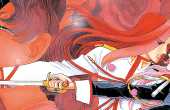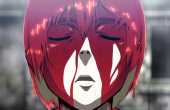ees
PhD candidate in philosophy. manga/anime enthusiast.
Contributor III
- Plebian Penman
- Lurker
- Pssst
- Sharp-Eyed Citizen
- Town Watch
- Otaku
- Article of the Month
- ?
- Articles
4 - Featured
4 - Comments
26
- Ext. Comments
12 - Processed
19 - Revisions
15
- Topics
8 - Topics Taken
4 - Notes
34
- Topics Proc.
98 - Topics Rev.
12
- Points
2127 - Rank
68 - Score
1077
Latest Articles
Latest Topics
Ghost in the Shell & Akira: Manga vs. AnimeGhost in the Shell (1995) and Akira (1988) are each widely acknowledged for their impact on the cinematic world as well as for propelling anime into the global world of popular culture. However, each of these films emerge from or are, perhaps loosely, based on accompanying manga series. While each manga series was published and had its "original run" prior to the creation and release of each film, the plots of the anime versions of both Akira and Ghost in the Shell in some ways present vastly different storylines and themes. Analyze the ways in which each anime film overlaps with or diverges from its respective manga predecessor and the significance of these similarities and differences. |
We Appreciate PowerGrimes has just recently released a new single, "We Appreciate Power," along with an accompanying music video. Analyze the message(s) that Grimes is attempting to send with her lyrics, the aesthetics of the music video, or even the musical influences for the song itself.
|
Channel Zero: Candle CoveChannel Zero, a new anthology series based off of popular stories on Creepy Pasta (a horror "microfiction" platform), has two seasons available on Shudder, a media platform similar to Netflix that caters to horror fans. Analyze various themes within the first season of Channel Zero, "Candle Cove," or compare and contrast Candle Cove with the following season, "No-End House." For example, while Candle Cove draws the viewer in with a murder-mystery approach that is later muddled by supernatural forces, No-End House seems to dive right in with the other-worldly approach. |
Existentialism in AnimeWhat is living, and what does it mean to be human? Analyze themes of existentialism through various anime series; this could include series such as Evangelion, Haibane Renmei, or Ghost in the Shell.
|
Published | This is AmericaDonald Glover has been a topic of conversation- some praise, some critiquing- for his recent release of the song "This is America," and the music video that followed. Analyze and/or critique Childish Gambino's newly-released "This is America." What is being implied, implicitly or explicitly, through the imagery of the music video as well as his lyrics? It would be prudent to pay special attention to the subtle nods to various events throughout the music video, and perhaps bring in critical race theorists such as Charles Mills (author of "The Racial Contract"), James Baldwin, Angela Davis, or Audre Lorde. |
Portrayals of Female Sexuality in Boruto Next GenerationsAfter Naruto ended, it didn't take long for a sequel- Boruto- to emerge from the woodwork. The manner in which Ukyo Kodachi and Mikio Ikemoto portray the women/girls in their creation is vastly different from Kishimoto stylistically; this can be seen in the way that they dress, the way they talk about boys, or just their behavior in general. Why the sudden need for the sexualization of young Kunoichi, and how does it differ from Kishimoto's method of expressing femininity throughout the Naruto franchise?
|
Kanji: Lost in TranslationFor most avid manga-readers, there have been times when a joke has gone right over our heads, or it has seemed like a character is speaking repetitively. The main culprit of this is the way that Kanji resists interpretation. Research and analyze how Kanji's inability to be interpreted in a way that is universally accessible has affected art and pop culture as it relates to universal cultural understanding.
|
Published | Themes of violence in Psycho-PassGen Urobuchi's Psycho-Pass exhibits varying themes of both implicit and explicit violence. I would be interested for the various kinds of violence depicted in Psycho-Pass to be explored: violence enacted by the government onto certain characters, violence inflicted by one character onto another, or even violence directed by a character onto themselves. Some thinkers that I have considered on my own when thinking about this topic are Hegel, Nietzsche, and Caillois.
|
Latest Comments
| Violence in Anime: Helpful or a Hindrance? | |
Mulan has always been my favorite Disney movie~ I really enjoyed your analysis of the film as well as what aspects of Mulan’s character make her so relatable and likable. | Mulan's Relatability, Self-Discovery, and Selfishness |
thank you for your comment! however, i don’t believe that i ever say that Grave of the Fireflies depicts the atomic bombs, nor do i claim that the children die in the bombings. what i hoped to illustrate by bringing in works like Fireflies and Barefoot Gen was that works like these share in a collective narrative and exploration of national trauma—at least, this is what many theorists claim. thanks for reading! | Akira: An Analysis of the A-Bomb and Japanese Animation |
thank you! that means a lot~ it was a pleasure to be a part of revising your article and seeing it published! | My Hero Academia: The Hidden Depth of All Might vs All for One |
very excited to see this article published! BNHA is an amazing show & I believe you really did justice to the depth of the characters and the pivotal role this fight plays both for the plot as well as character development. good work! | My Hero Academia: The Hidden Depth of All Might vs All for One |
I would say that you’re definitely on to something there, and I think Freiberg’s theory of the post-nuclear sublime may play into that as well. As Bolton notes in his essay Akira’s premier in the United States had such an impact due to the innate qualities of dread and desire that the post-nuclear sublime incites. Being citizens of the nation that was responsible for so much destruction very likely plays a major role in this. | Akira: An Analysis of the A-Bomb and Japanese Animation |
I think that there is a lot to be said for how reading the manga as well as watching the film can influence one’s understanding or interpretation of either medium. It’s very possible that reading the Akira manga could perhaps clear up a few things that are confusing about the anime, but ultimately I believe that each medium accomplishes very different things and in very different ways, stylistically speaking. Even the endings of each work are drastically different, and thus leave the viewer/reader with a very different message. Bolton delves further into the similarities and differences between the two in his own article, and I think there is so much more to be said/investigated in regard to the relationship between the manga and the anime! | Akira: An Analysis of the A-Bomb and Japanese Animation |
Perhaps it could be argued that those more familiar with the manga can better grasp what’s going on in the film. However, I don’t think you should be too quick to dismiss the point of many theorists that the goal of Akira as a film goes beyond the plot of the original (I use this word tentatively) work of the manga. I would implore you to not be so quick to dismiss it as “muddled,” or only working to cater to people who are familiar with Akira’s broader context. Further into Bolton’s analysis of the film that I reference he brings in the manga and investigates it alongside the film, saying that “although the film was in some sense adapted from the manga, it is not my intent to treat the manga as a backstory or a better story that will answer all our questions about the anime. That would simply replace one origin with another, replacing genbaku (the nuclear bomb) with gensaku (the nucleus of the franchise, the original text).” I think such an approach is very interesting, and that upon further investigation this perspective undermines critiques like the one you give here that the film is completely based on the manga and that those more familiar with the broader body of work behind Akira have some sort of deeper insight. | Akira: An Analysis of the A-Bomb and Japanese Animation |




of course it is not “entirely true,” hence the inclusion of the word “likely” and the phrase “little to no violence.” one can certainly find exceptions to this rule. However, “typically,” shoujo does not feature violence––or at least not the same type of violence––that shounen offers.
as to your second comment, certainly one can draw parallels between the diclonius and disability. however, since research material concerning this particular fandom (elfen lied wiki, for example) refers to diclonius as a “race,” i chose this route instead. both are valid interpretations of the position the diclonious occupies within the manga and are worth exploring.